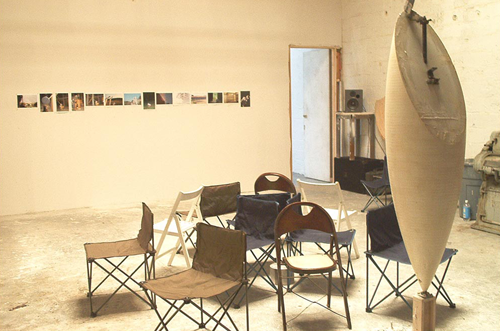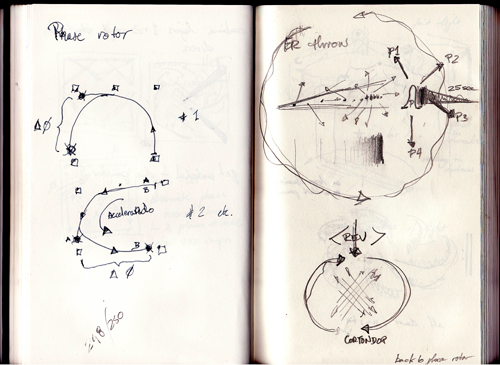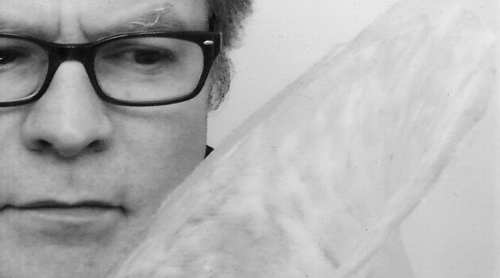Douglas Henderson
Born in 1960, Douglas Henderson studied music composition and theory with Milton Babbitt, Elie Yarden and J.K. Randall. He received his Ph.D. in Music Composition from Princeton University in 1991, his M.A. from Princeton in 1985 and his B.A. in Music from Bard College in 1982. He previously chaired the Sound Art Department at the School of the Museum of Fine Arts, Boston, and now works and lives in Berlin and Brooklyn.
Currently represented by Galerie Mario Mazzoli (Berlin), he was a guest of the DAAD Berliner Kuenstlerprogramm in 2007, and a Foundation for Contemporary Arts 2007 Recipient. He received a 2008 Rockefeller Foundation MAP Award, shared one with with Luis Lara Malvacias in 2005 and was awarded a 1998 “Bessie” (New York Dance and Performance Award).
Performances and installations at the Whitney Museum of American Art, daadgalerie, Art in General, ArtForum Berlin, Artefiera Bologna, The Kitchen, Diapason Gallery and Dance Theater Workshop. Have enjoyed the support of grants from Meet The Composer, the Mary Flagler Cary Charitable Trust, The Lila Wallace/Reader’s Digest Fund, Creative Time, and the New York State Council for the Arts, and his compositions have been included in numerous international festivals from New Music America in New York to the Seoul International Festival of Computer Music in South Korea.
He has been composing, performing and building in New York City and internationally for more than 24 years with a variety of artists and musicians, including John Zorn, Zeena Parkins, Ikue Mori, Jude Tallichet, Kristin Lucas and David Scher. He has composed extensively for modern dance choreographers such as Meg Stuart, Jeremy Nelson, David Zambrano, Jennifer Monson and Yvonne Meier, as well as for Ricochet Dance (London, UK) Phoenix Dance Theatre (Leeds, UK) and Wildadance (DK). He has toured extensively in the U.S. and in Europe performing original work and in the 1990’s with experimental punk/noise bands Spongehead and Krackhouse.
The Nature of the 102nd Thing (of 10,000),
a 4 channel electroacoustic sound sculpture

The Nature of 102nd Thing (of 10,000) is a 4 channel electroacoustic sound sculpture built on an architectural model, rather than a traditional music structure. Physical forms moving and changing in time are embodied by spatialized sounds. The title and inspiration develop out of an ancient Taoist definition of infinity: 10,000 was considered to be a large enough number that it was not necessary to count beyond it: “the 10,000 meant “the unknown Universe” or “the boundary beyond which it is not necessary to imagine”. This piece chronicles the effort to exceed boundaries, to defy the mind’s fishtank of self-imposed limitation. As a child I walked along a wall on my way to school every day. I did not wonder what was behind the wall: for me it was the unquestioned limit of the world. Walking the same path many years later, what is unfamiliar is not that everything seems small in relation to my greater height, but that the world is so much larger, because the horizon is extended by my larger curiosity. The universe of the path and the wall has become an islet, swamped in understanding of maps and land ownership. As my notion of 10,000 has been redefined, the edges of the world have fled steadily outward; and so this piece unfolds in time as a series of spinning circles of sound energy, pressing against the walls, barely contained and transected by creaking wooden joints.
The Nature of the 105th Thing (of 10,000)

In the 10,000 Things series Douglas Henderson uses spatial architecture to structure his music. The space, location, movement and shape of sound are the the primary considerations, while the needs of this sonic holography dictate all choices in the composition. The 105th Thing (of 10,000) seeks to describe a subterranean rotor, constructed using the heavily edited and processed sounds of a subway car rounding the corner of Alexanderplatz in Berlin. By employing rapid, violent reversals of acoustic phase relationships, virtual propellers emerge, and begin to rotate, flying closer and closer in a darkened cloud; and once established, the image is gradually erased by inserting increasingly numerous grains of silence, until all is blank.

